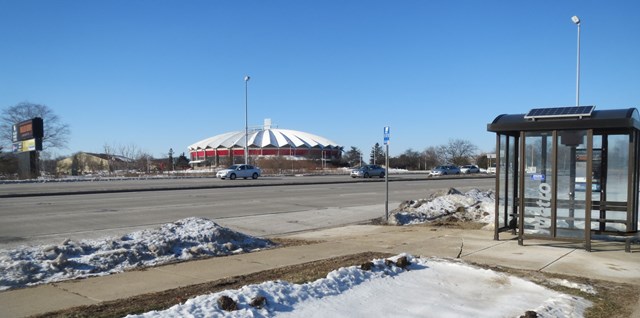|
|
The future of Dane Countyís Coliseum and the rest of the Alliant Energy Centerís campus has been a hot topic of discussion lately. Why should a bus rider care? Alongside fast-moving
John Nolen Drive and near the Beltline, the County Fairgrounds and environs was built up almost half a century ago for the
convenience of car users, not transit riders.
The County does not help pay for any transit service to its Coliseum or any other County facility (including the airport), and what limited bus service there is to the Coliseum or Exhibition Center, is paid for by the neighboring Town of Madison. The consequent inhospitality to a bus rider is apparent even before alighting from the No. 13 bus. The bus stops are exposed after-thoughts (shelterless and benchless) at the end of huge parking lots with no sidewalks, while the bus itself does not even travel as far north from the South Transfer Point as downtown Madison where one may need to transfer to continue journeying crosstown. Even so, the bus rider should care because the Coliseum area (now known as the Alliant Energy Center) is ripe for an upgrade that could include a terrific new mass transit line of acclaim and appeal. No longer would a transit-dependent individual have to forego meetings, concerts or other public events that would take place at a location requiring a car. The Coliseum is situated on a vast parcel of underutilized land Ė 164 acres in all, only a couple miles from downtown Madison. And currently, despite hosting such events as the World Dairy Expo, the Alliant Energy Center is losing money. It used to host many more events and attract a large clientele. No longer. The County commissioned a feasibility study for the area in early 2013 that came out very recently, at the end of October 2015, with the tantalizing passage: Access from major highways and proximity to downtown make the AEC [Alliant Energy Center] campus a prime location for a transportation hub to serve Madison and the surrounding area. A transportation hub could include an element that moves visitors quickly and easily from the AEC [Alliant Energy Center] campus to downtown Madison and University of Wisconsin (p. 108) That in turn motivated the following Letter to the Editor of the local Cap Times by Philip Heckman (12/8/2015): Imagine a light rail line linking the renovated Coliseum to Monona Terrace and the future east side public market. This connection would benefit all three sites by decentralizing parking while encouraging visits to the amenities that the other two areas provide. Furthermore, such a line could ultimately extend to the airport (and beyond) in the future. Let me add to both those ideas because elsewhere in the report, it is mentioned that the area has huge surface parking lots that together provide over 5,500 stalls. Not that what I add are not ideas that have been bandied around for years already, but it helps to connect some dots. One idea is to reconsider the Countyís downtown parking policy. The County currently maintains a parking structure downtown with about 1,000 stalls at the corner of Henry and Fairchild Streets administered by the same department responsible for the Alliant Energy Center Ė the Department of Public Works, Highways and Transportation. County employees can reserve a spot in that structure for all of $15/month or $180/yr. The normal charge for parking there is $1.50/hour or $15/10 hours. It has been suggested that the special employee discount only be applicable for parking at the Alliant Energy Center while the downtown ramp only charge regular rates. Revenue from its normal use as well use of the parking at the Alliant Energy Center could more than pay for good shuttle service between the Alliant Energy Center and downtown, thereby increasing the accessibility of both areas to a much larger population. There is precedence for this type of thinking as the UW-Madison has several off-campus parking lots where it can charge much less for parking: instead of charging over $800/year for a spot on campus (that may not be available during special event days anyway), it only charges $265/year to park off campus and ride a shuttle. The second idea is an extension of Heckmanís although it could involve shuttle buses instead of light rail, at least to begin with Ė connecting the Alliant Energy Center to the airport via downtown, a public market and the UW campus. As already mentioned, the County provides NO transit service to or from downtown to the airport. Yet both Madisonís downtown Monona Terrace Convention Center, and the fairly near Alliant Energy Center campusís Coliseum and Exhibition Hall purport to serve a regional, national and sometimes even international clientele who do not come to Madison via an automobile or expecting to have to drive everywhere. The University of Wisconsinís internationally-renowned campus has students and research staff who are busy regional, national and international travelers as well. The hospitality industry, the business community and the University of Wisconsin would thus all benefit from, and could contribute to, the existence of a transit line from the Alliant Energy Center to the airport.
With an airport-Alliant Energy Center transit connection, Madison and Dane County would earn the reputation of being a welcoming and pleasant travel and business location while the ordinary citizen could expect to frequent public
events without needing to use an expensive automobile.
|

